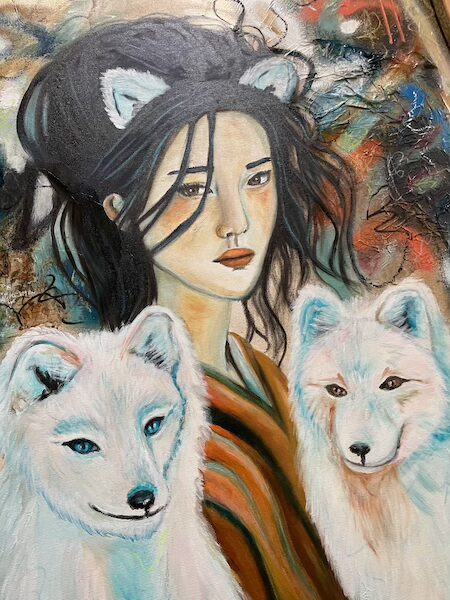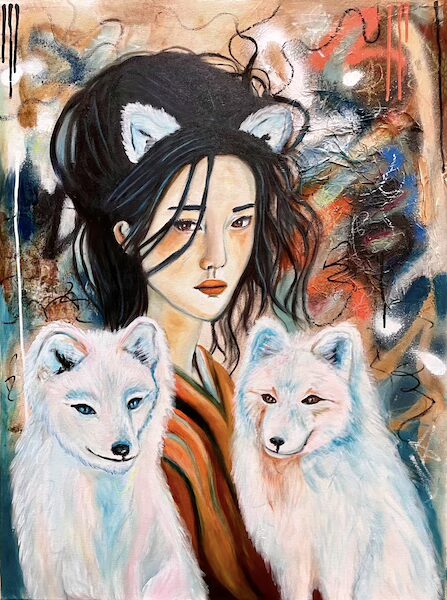
The Japanese goddess Inari and her meaning: fertility, abundance, transformation
The goddess Inari plays a central role in Japanese mythology. She is the goddess of fertility, rice, agriculture and prosperity. Her worship goes far back into the past, and her significance has not only endured over the centuries, but has also changed time and again.
Inari symbolizes not only abundance and security, but also transformation and adaptability - qualities that are still relevant in our modern world.
Goddess Inari's origin and meaning in mythology
The goddess Inari is best known for her association with rice, a staple food and an important symbol of life and abundance in Japan. She is often invoked as the protector of farmers and the harvest, but her domain extends far beyond the fields. Inari is also the goddess of crafts and industry and is even depicted as androgynous or masculine in some traditions, emphasizing her mutable nature.
The famous Inari shrines, such as the Fushimi-Inari-Taisha in Kyoto, are characterized by the iconic red torii gates, which are often arranged in long rows. These gates symbolize the transition between the physical world and the spiritual realm and reflect Inari's role as an agent of change.
Inari is also closely associated with foxes (kitsune), which are regarded as her messengers or guardian spirits. These foxes carry a deep symbolism that goes far beyond their mythological function.
The white foxes - Inari's ambassadors
The white foxes, kitsune, are the loyal companions and messengers of the goddess Inari. They are considered sacred and represent wisdom, protection and magic. In mythology, they can switch between the human and spiritual worlds, which gives them a mystical aura. They are often depicted as guardian figures in front of the shrines of Inari, with a bundle of ears of rice in their mouths, emphasizing the connection to fertility and abundance.
Their color plays an important role in the symbolism of the kitsune. White stands for purity, divine power and protection from evil spirits. The foxes also embody cunning and intelligence, qualities that can be interpreted both positively and negatively - an indication that change and growth are often accompanied by dual aspects.
In the modern world, the kitsune remind us that transformation does not succeed without wisdom and adaptability. They teach us that change often needs to be approached with a pinch of courage and sometimes a spark of cunning in order to make the best of it.
Goddess Inari's significance for the present day
Inari can be seen as a timeless source of inspiration, as it stands for themes that are still relevant today: Constant change and the balance between the tried and tested and the new. As the goddess of prosperity and fertility, she reminds you that harvest - whether in the physical or symbolic sense - comes from dedication and patience. And also that you should first take care of the "roots" before a project can bear fruit. This means as much as: Make sure that your project is built on a solid foundation before you expect results.
Inari also symbolizes the power of transformation. Her message is that change should not be seen as a threat, but as an opportunity. Like the rice that is sown and harvested anew year after year, she encourages you to let go of the old and make room for the new.
The kitsune, their animal companions, can be seen as companions in situations of change / transformation. They tell you that it is wise to proceed with caution and at the same time remain courageous and flexible.


My picture "Inari & The Foxes"
In my painting, I have tried to capture these qualities and messages artistically. The foxes, as central elements of the depiction, stand for transformation and the path between the worlds.Inari also has fox ears in my picture, which is intended to remind us a little of manga characters, but above all emphasizes her connection to the magical beings. Inari herself is like her foxes - and gives you the message that you can also "shape-shift", i.e. feel your way into certain states (e.g. your wishes) until you become them and your personal reality adjusts accordingly.
I used collage elements in the painting to illustrate the connection between tradition and modernity. This technique reflects Inari's role as a goddess of change and shows how she is still relevant today.
The modern markings (including neon acrylic pens in the bottom layer) and colors I used represent the vibrancy and timeliness of Inari's message. Especially the golden accents and the powerful color palette highlight the goddess and her symbolism - a symbol of wealth, not only in the material sense, but also in the spiritual and emotional sense.
The image is an invitation to connect with the qualities of Inari and her foxes, to find the courage to change and to recognize your own capacity for transformation. Inari reminds you that change is not an end, but a new beginning that can make you richer and more fulfilled - if you are open to it.
